The Limits of the Earth — Part 1: Problems
April 18, 2013 by Ramez Naam
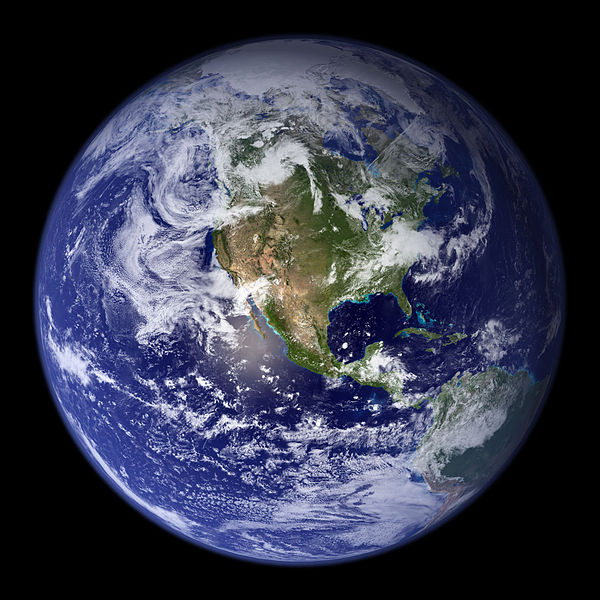
(Credit: NASA)
This is part one of a two-part series on the limits of human economic growth on planet Earth. Part one details some of the environmental and natural resource challenges we’re up against. Part two, on the ultimate size of the resource pool and solutions to our problems, will be published tomorrow and linked here. Both parts are based on Ramez Naam’s new book, The Infinite Resource: The Power of Ideas on a Finite Planet
The world is facing incredibly serious natural resource and environmental challenges: Climate change, fresh water depletion, ocean over-fishing, deforestation, air and water pollution, the struggle to feed a planet of billions.
All of these challenges are exacerbated by ever rising demand — over the next 40 years estimates are that demand for fresh water will rise 50%, demand for food will rise 70%, and demand for energy will nearly double — all in the same period that we need to tackle climate change, depletion of rivers and aquifers, and deforestation.
One view of these looming threats is that we’ve exhausted planet’s resources. We’ve overshot the planet’s carrying capacity. Economic growth — the root problem driving our growing consumption and pollution — has to end. Indeed, the global economy may even need to shrink to avoid complete ecological disaster. That’s the thesis of a long line of environmental books, from The Limits to Growth to Peak Everything.
The problems
Looking at this large array of problems, it would be easy to agree with the Limits to Growththesis — we are simply consuming too much and polluting too much. The underlying driver — economic growth — can’t keep going without sending us over a precipice.
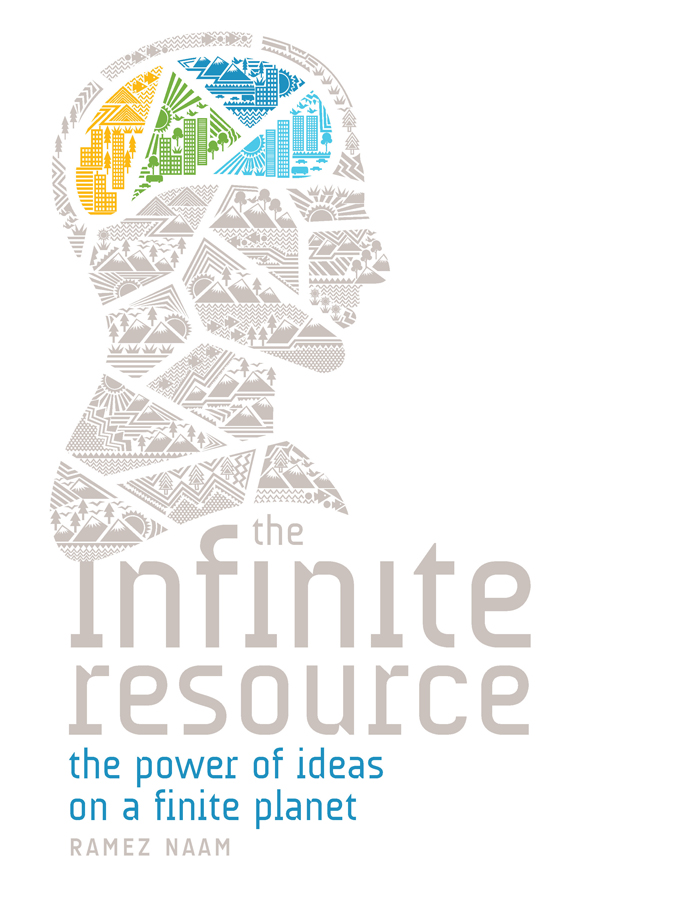 In my own new book, The Infinite Resource: The Power of Ideas on a Finite Planet, I challenge this view. The problem isn’t economic growth, per se. Nor is the problem that our natural resources are too small.
In my own new book, The Infinite Resource: The Power of Ideas on a Finite Planet, I challenge this view. The problem isn’t economic growth, per se. Nor is the problem that our natural resources are too small.
While finite, the natural resources the planet supplies are vast and far larger than humanity needs in order to continue to thrive and grow prosperity for centuries to come. The problem, rather, is the types of resources we access, and the manner and efficiency with which we use them.
And the ultimate solution to those problems is innovation — innovation in the science and technology that we use to tap into physical resources, and innovation in the economic system that steers our consumption.
The situation we’re in isn’t a looming wall that we’re doomed to crash into. It’s a race — a race between depletion and pollution of natural resources on one side, and our pace of innovation on the other.
I’m not claiming here that we’re assured of victory. Rather, I’m claiming that winning — greatly expanding the global economy while at the same time shrinking or even reversing our impact on the planet — is possible. Whether or not we achieve that depends in very large part on the choices we make.
So with that, let’s take a closer look at the problems, at why ending growth isn’t a viable solution, at the true resources of the planet, and at what we need to do to win this most important race.
Feeding the World:
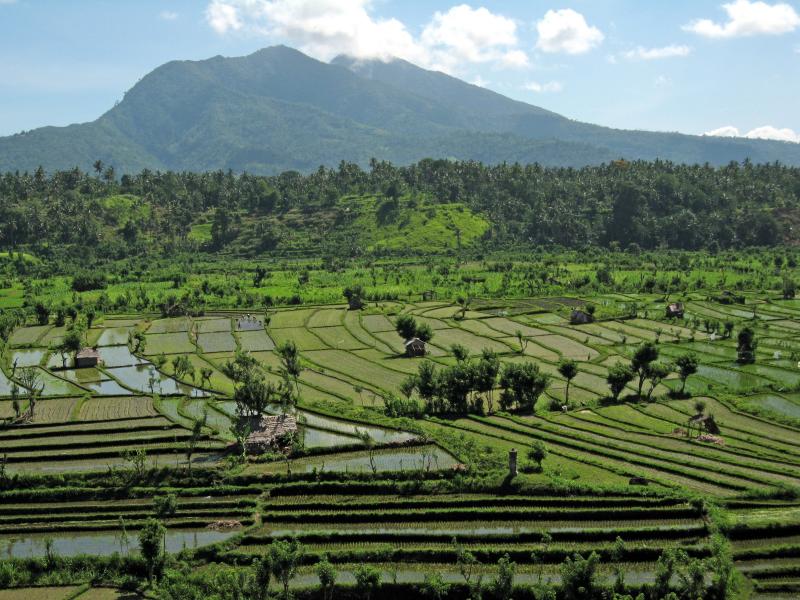
Humanity has converted roughly a third of the Earth’s land area to the production of food — by far the largest environmental impact we’ve had. Image: Wikipedia
Food production has affected the environment more than any other activity humans have engaged in. Humanity devotes more land to food production than anything else — roughly a third of the surface area of the earth, much of which was once forest but has been converted by humans into farms or grazing lands. Agriculture also contributes to a host of other environmental and resource challenges.
Nitrogen runoff from fertilizer used on US farms in the Midwest has created an 8,000 square mile dead zone in the Gulf of Mexico, an area roughly the size of New Jersey. Runoffs of pesticides are the number one source of pollution in US lakes and rivers. Farm irrigation uses 70% of the world’s fresh water, a resource increasingly under pressure.
Despite that heavy investment of resources and the significant negative side-effects of agriculture, food production is falling behind demand. Between 2002 and 2008, worldwide food prices soared, as demand — particularly from Asia — spiked, while production rose only modestly. Prices today remain more than double their levels of a decade ago. Prices dropped a bit as the recession of 2009 slowed demand, but are now back at record highs. Those high prices, in turn, have stalled progress in reducing global hunger rates. They may also have contributed to the unrest of the Arab Spring.
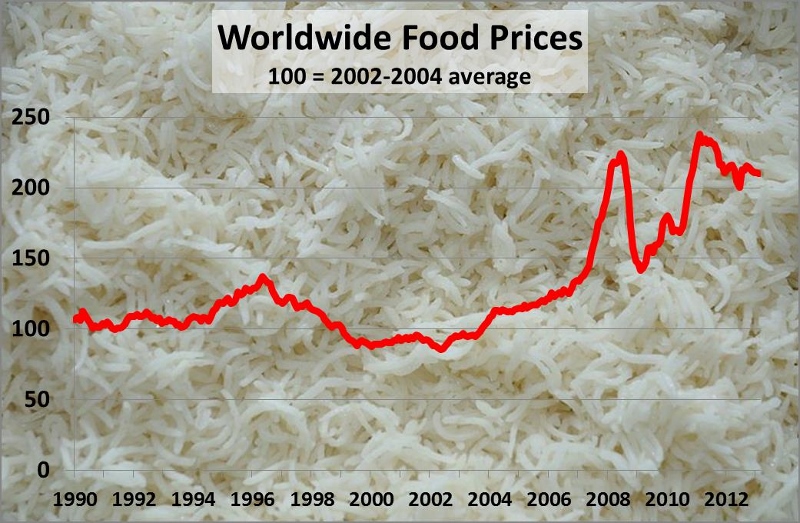
Food prices spiked at more than twice their historic levels in 2008 and again in 2011. They remain well above their long term averages now. Source: FAO
Worse may be yet to come. Even as food prices hover near record highs, demand is rising. The Food and Agriculture Organization of the United Nations estimates that, by 2050, we will need to grow 70% more food than we do today to feed the world.
If food production doesn’t rise by that amount, prices will rise further. Hunger — something we’ve made steady progress against for 40 years — may rise once more. Political unrest and global instability may follow.
Deforestation
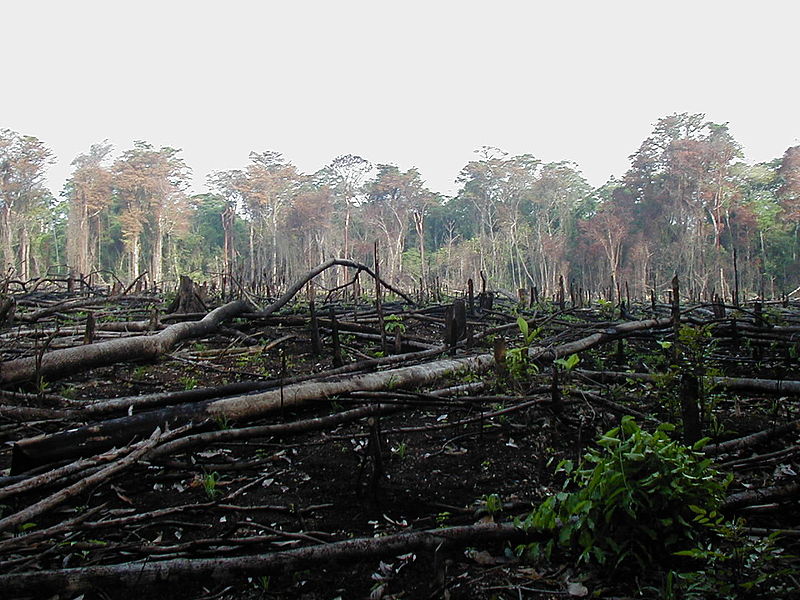
More than half of the prehistoric forest of the Earth has been cleared by humans, primarily to grow food. Image: FAO.
The most obvious way to grow more food is to turn more land over to the task. But that runs hard into another ecological problem: Deforestation.
In prehistoric times, roughly half of the earth’s land surface was forested. Today only half of that forest area remains, the rest having been converted into farm land and grazing land by human hands. And every year, the planet loses roughly another 50,000 square miles, an area roughly the size of Louisiana. Much of that is in the tropics. Since 1950, a full 60% of the world’s tropical rainforests have been destroyed.
Nevertheless, those forests are the most obvious place to expand farming into. The rest of the land on the surface of the planet is either already farmed; is covered in desert, mountain, or swamps; or is used up by cities and towns. And indeed, in the tropics, agriculture is the #1 contributor to deforestation, accounting for an estimated 80% of the forest chopped down.
The planet’s forests are, as The Economist called them, the world’s lungs. They consume CO2 from the atmosphere, converting it into wood and leaf. The world’s forests contain around one trillion tons of carbon (or 3.7 trillion tons of CO2) — equivalent to nearly a century of human emissions. They emit a quarter of the oxygen that feeds all other animal life on earth, including humans. They provide a safe haven for millions of species found nowhere else.
The rain forests alone are estimated to contain 75% of the biodiversity found on land. Forests keep topsoil in place that would otherwise fly away. (Sadly, when topsoil that was once forest blows away, forests suffer, as bordering farmers chop more of it down to acquire more land to make up for the drop in productivity of their current lands.) And, through a process called evapotranspiration, forests bring rain to areas downwind of them. Tropical rainforests alone produce around 20% of the world’s oxygen and 30% of the world’s fresh water. Human activity that damages them has wide reaching effects.
Feeding the growing appetite of humanity by simply farming more land simply isn’t an option — unless we want to accept the release of hundreds of billions of tons of CO2, the disruption of local precipitation patterns, and the extinction of hundreds of thousands of species as an acceptable loss.
To preserve our remaining forests, we’re going to need to grow more food without farming more land.
Fresh Water
Farming (and to a lesser extent, other human activities) are also placing a huge stress on fresh water supplies. Water is life. Agriculture depends upon it. Nearly 70% of the water humanity uses is for irrigation. Growing food for an average human diet requires an estimated 320 gallons of water a day. For an average American diet the number is closer to 900 gallons of water a day. To produce that water, we’re drawing down rivers, lakes, and fossil water aquifers at an unsustainable rate.
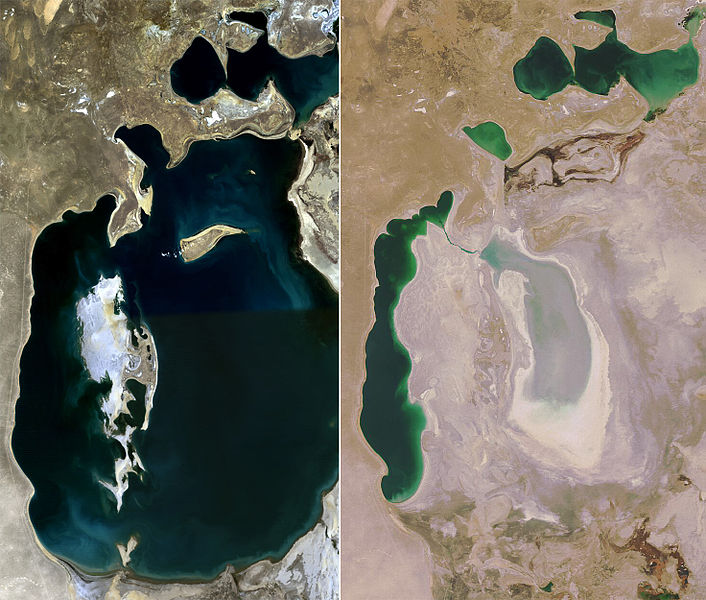
The Aral Sea, once the fourth largest fresh water body on Earth, before and after. The sea has been almost completely drained for agriculture. Image: NASA
Beneath the American high plains of Nebraska, Kansas, northern Texas, and five other states lies the Ogallala Aquifer, a giant underground reservoir of fresh water that farms and people in the region depend on. Ogallala is full of ‘fossil water’ — the remnants of the glaciers and ice sheets that retreated from this area more than 10,000 years ago, melting and filling underwater basins as they went. That fossil water is used to irrigate 27% of the farmland in the United States.
Ogallala’s water level is dropping, in some places as fast as three feet per year. In two months the water we withdraw from Ogallala is enough to fill a cube a mile on a side, enough to cover every inch of the island of Manhattan in more than 200 feet of standing water.
Water is abundant on our planet. Oceans cover 70% of the Earth’s surface. Their combined volume is huge. Even freshwater is vast in quantity. It literally falls from the sky.
Yet the rate at which we consume water — particularly for agriculture — exceeds the rate at which we can capture it from rain or from sustainable withdrawals from rivers. To feed our planet, we’ve turned to more extreme methods, draining some rivers dry, and pumping water out of aquifers that will take thousands of years — if not longer — to refill once we’re done with them.
The Indus River Valley aquifer under India’s breadbasket is being drained at a rate of 20 cubic kilometers a year. Water tables in Gujarat province are falling by as much as 20 feet a year. The giant North China Plain aquifer, which provides irrigation for fields that feed hundreds of millions, has been found to drop as much as 10 feet in a single year. A World Bank report cautions that in some places in northern China, wells have to be drilled nearly half a mile deep to find fresh water. Hebeiprovince, one of five atop the aquifer, has seen more than 900 of its 1,052 lakes dry up and disappear due to dropping water tables. In Mexico’s agricultural state of Guanajuato, the water table is dropping by 6 feet a year. In north eastern Iran, it’s dropping by as much as 10 feet a year.
Water is being withdrawn from rivers as well. Seasonal water levels are dropping on China’s Yellow River, on the Nile in Egypt, on the Indus as far north as Pakistan, and on the Rio Grande in the US. Parts of the Colorado River are a stunning 130 feet below their historic levels. The river no longer reaches the sea. Nor does the Yellow River or dozens of others around the world that have been tapped for irrigation. The rivers that flow through Central Asia have been so massively drained for agriculture that the vast Aral Sea they once fed, once the fourth largest freshwater lake in the world, is now little more than a dry, salty lakebed, its former shore dotted with abandoned fishing villages and the bones of beached boats.
On current course and speed, the Ogallala aquifer will run dry before this century is over, and possibly much sooner. The North China Plain aquifer will run dry. The Indus River Valley aquifer will run dry. And when they do, the cost to agriculture — and thus to human life — will be enormous.
Ocean Overfishing
In the oceans, the situation is nearly as dire. Fish are an essential human food source. Worldwide, they provide 16% of the protein humans consume. In Africa, they provide 21%. In Asia, a whopping 28%. In some individual countries, fish are even more vital. Fish provide 65% of the protein available in Ghana, 58% of the protein available in Indonesia, and 50% of the protein available in Bangladesh. Worldwide, a billion people rely on fish as their primary protein source.
Fish are, in principle, a renewable resource. They breed to create more fish, turning nutrients in the oceaninto forms that humans and other animals can readily consume.
Yet even renewable resources have their limits. When hunted too rapidly, fish populations can collapse. The number of adult breeders that remain can be too low to rebuild the population as they deal with predators, with competitor species, and with the continued pressure of human fishing. That sort of collapse has happened again and again in recent years, with disastrous impacts for both fish species and humans.
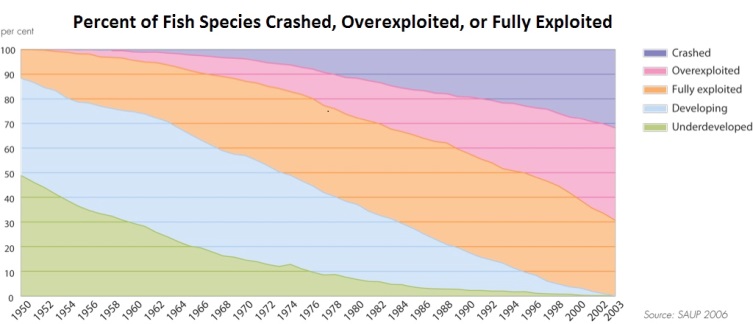
More than a third of all ocean fish species have seen their populations crash. Virtually all others are overexploited or being exploited to the maximum possible already. Image: SALIP
Today, the Food and Agriculture Organization of the UN estimates that a third of fish species have either crashed already or are overexploited and pushed to the edge. Another half of all fish species are fully exploited, with no room to grow production. If the demand for fish continues to grow at or near past rates, the FAO believes global fisheries could completely collapse by 2050.
If we want to keep eating fish for the rest of this century, we need to find a better way to acquire them.
Climate Change
Then there is the problem that exacerbates all others.
Our planet is warming. CO2 and other greenhouse gases released by our relentless burning of fossil fuels, our deforestation of the planet, and our livestock are accumulating in the atmosphere. Those gases, in turn, are trapping more heat that would otherwise have escaped into space.
The evidence is all around us. In 1850, Glacier National Park was home to 150 active glaciers. Today it has 25. By 2030 they could all be gone. Mt. Kilimanjaro, the highest peak in Africa, was covered a century ago by twenty square kilometers of glacier. Today it’s covered by less than three. Permafrost in the northenlattitudes is melting so badly that residents of at least four Alaskan villages are trying to relocate their entire towns to firmer ground.
And perhaps most dramatically, the Arctic ice cap is melting rapidly. In 1980, the smallest area covered by Arctic ice in summer was 8 million square kilometers. In September 2012 it was down to 3.4 million square kilometers. With the ice half as thick as it once was, the ice cap’s volume is barely a quarter of what it was thirty years ago.
As recently as 2007, the IPCC predicted that ice-free Arctic summer days wouldn’t arrive until the middle of the 22nd century, more than 130 years in the future. Now there’s the very real risk that we’ll see those first ice-free summer days by the end of this decade — more than a hundred years ahead of schedule.
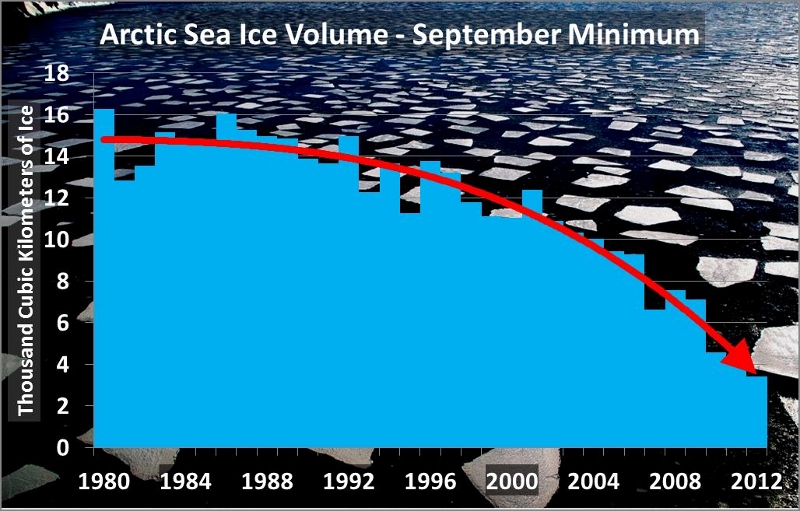
The volume of sea ice in September has dropped to less than a quarter of its levels in 1980. At this rate, the first ice-free September day could occur before the end of the decade, and the Arctic could be free of ice at the end of June by 2030. Source: NSIDC
The most commonly discussed impact of climate change is rising sea levels. And indeed, climate change is expected to raise global sea levels by 3 to 6 feet by the end of the century, not enough to drown the Statue of Liberty, but enough to put dozens of coastal cities and island nations at risk.
Yet there are other risks not so far in the future. Indeed, they’re here now.
In 2003, Europe went through its hottest summer on record since at least 1540. An estimated 70,000 people died from the heat wave. Fires destroyed 10% of the forests of Portugal. France lost 20% of its wheat harvest. Ukraine lost a whopping 75%.
Since then, record droughts hit China in 2009 and 2010, wiping out nearly half the winter wheat harvest, leaving 20 million people without adequate drinking water, and drying up wells that had provided water since 1517.
Climate change causes drought by increasing the moisture demand of the atmosphere. Every degree Celsius of warming increases the amount of water the air can hold by around 7%. But that moisture isn’t distributed evenly. Warmer air can whisk huge volumes of water away from one place, and bring it down in a sudden deluge in another.
And so, in May 2010, China also saw epic floods that killed more than 3,000 people, destroyed 1 million homes, and forced the evacuation of 15 million more.
In August of 2010, another heat wave struck Russia, setting record highs of 111 degrees Fahrenheit and killing 55,000 people across the country in just two months. In Moscow alone, 11,000 people died as a result of the heat.
And the US hasn’t been immune to the effects either. In 2012, the combination of Hurricane Sandy and devastating drought across the American South and Midwest inflicted a combined $100 billion in damage to the US. The drought alone wiped out a quarter of the US corn crop. And that drought, which began in 2011, shows no signs of abetting. Conditions this year, in the spring of 2013, are drier than they were in the spring of 2012.
It’s impossible to attribute a single, specific extreme weather event to climate change. Even if CO2 levels had never risen on Earth, some extreme weather events would occur. But it’s clear that extreme weather is becoming more common as the planet warms, just as models predict.
Heat waves are the clearest example. Record highs are now twice as common as record lows. But both record highs and record lows are now more common, as a warmer, more energetic atmosphere can move masses of air around more rapidly. And peer-reviewed studies have now shown that the deadly heat waves and droughts I’ve just mentioned — Europe in 2003, Russia in 2010, the US South and Midwest since 2011 — were all made many times more likely by climate change.
What will happen if the planet warms as expected on the business-as-usual path? Climate simulations show decade long dustbowls in the US, Africa, China, and parts of Europe, combined with torrential rains and monsoons in other areas, stronger and more frequent hurricanes in the Atlantic, and incredible periodic heat waves over much of the world.
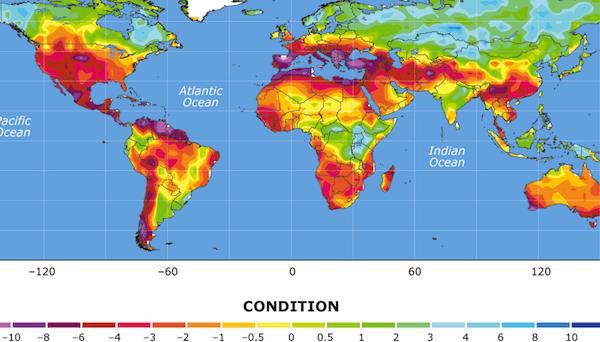
Climate models predict severe droughts across much of the world by the end of this century. For comparison, the US dust bowl was a -3 on this scale. Image courtesy of NCAR.
Climate change makes every other environmental problem worse. Drought has already taken its toll on the Amazon and other tropical forests. Heat and drought accelerate fresh water loss. Heat, drought, and extreme weather have decimated crops and threaten to do much worse in the future, making it that much harder to feed the population. And the other big effect of CO2 emissions release, ocean acidification, threatens the corals that are essential to the ocean food web — a food web already under pressure from human overfishing.
The Tipping Points
Climate change comes with an added risk — the changes we make to the planet may themselves accelerate warming. Consider the Arctic sea ice. Bright white ice absorbs only about 10% of the solar energy that strikes it, and reflects the rest back into space. But when Arctic sea ice melts, it exposes dark ocean waters beneath it. That dark water absorbs 90% of the solar energy that strikes it. That contributes to the melt of the rest of the ice, as the waters near the Arctic warm more quickly as they’re absorbed. It’s also significant on a planetary scale. If the entire Arctic were ice-free throughout the whole of summer, the added heat captured would roughly equal the total amount of heat captured from all human CO2 emissions to date.
Let me say that again — if the Arctic were ice free throughout the sunniest months of summer (something that could happen within 20 years at the current pace), then even if we ended all human CO2 emissions, the planet would keep warming at a pace similar to the one that it’s on now. And of course, if we don’t end human CO2 emissions, the increasing energy absorption of a dark Arctic will accelerate the pace of warming.
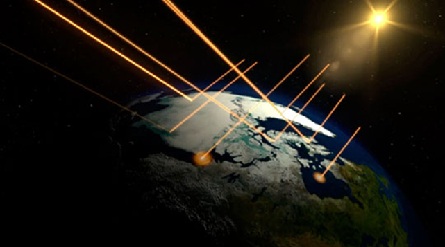
As the Arctic sea ice melts, it exposes darker waters below that capture far more of the sun’s energy, speeding warming of both the region and the planet. Image: NASA
Nor do the feedback loops stop there. As the Arctic melts, the permafrost in Siberia, Canada, and Alaska is melting with it. Below that permafrost is another trillion tons or so of carbon. As the permafrost melts, some of that carbon will emerge into the atmosphere. And a fraction of it will emerge in the form of methane, a gas that is 25-30 times more powerful in its greenhouse effect than CO2. How much warming that’s likely to contribute is still a topic of much debate, but at the upper end, it could also equal human emissions.
In short, we’re on the verge of setting off chain reactions that will keep the planet warming — and accelerate the pace — even after we cease our burning of fossil fuels.
The End of Growth?
The situation we’re in is dire. We’re doing damage to the very systems that we depend upon for survival. What’s the cure?
One refrain is that the core problem is economic growth. The Limits to Growth, the best-selling environmental book of all time, used computer models to demonstrate that unchecked economic growth would eventually lead to overconsumption, over-pollution, or both, sending us off a precipice that would lead to a collapse of human populations and well-being.
Bill McKibben, author of half a dozen environmental books and a leading activist for a low-carbon world, someone for whom I have a tremendous amount of respect, calls economic growth “the one big habit we finally must break.”
Paul Gilding, former head of Greenpeace International, titled his most recent book The Great Disruption: Why the Climate Crisis Will Bring on the End of Shopping and the Birth of a New World. He writes, “The Earth is full. In fact our human society and economy is now so large that we have passed the limits of our planet’s capacity to support us and it is overflowing. Our current model of economic growth is driving this system, the one we rely upon for our present and future prosperity, over the cliff.”
Richard Heinberg of the Post-Carbon Institute, author of Peak Everything, named his latest book The End of Growth: Adapting to Our New Economic Reality. He opens his book with his thesis: “Economic growth as we have known it is over and done with. The ‘growth’ that we are talking about consists of the overall size of the economy and of the quantities of energy and material goods flowing through it. […] The general trend-line of the economy (measured in terms of production and consumption of real goods) will be level or downward rather than upward from now on.”
There are reasons both to hope and to believe that all of these statements are incorrect.
We must hope that economic growth isn’t over on two separate grounds:
The first is the moral ground. Roughly one billion people alive today on the planet have access to automobiles, air conditioners, and central heat. The other six billion do not. Two billion lack access to a toilet. One billion lack access to electricity. The bulk of the growth to come over the next few decades — in global GDP, in energy consumption, in CO2 emissions, in food consumption, in water use — will all come from the developing world. That growth isn’t trivial. It isn’t about building McMansions or driving SUVs. It is, by and large, growth that reflects the aspirations of billions of people around the world to rise to a level of comfort that nearly everyone in the rich world — even those we consider poor — enjoy. A path forward that doesn’t allow room for billions to rise out of poverty and to at least this modicum of comfort is not a very appealing one.
The second is the practical grounds. What power do we have to stop those in the developing world — where almost all the real growth is to come — from consuming more? Very little. Perhaps it is resource scarcity itself that will halt the growth of consumption. But if so, that won’t happen easily or peacefully. As demand for energy, food, and water all rise, if supplies remain stagnant (or even drop) prices will rise, unrest will kick in, and violent conflict is a very real possibility. Already we’ve seen that drought helped start the civil war in Sudan’s Darfur region that took hundreds of thousands of lives, and that China, India, and Pakistan — three nuclear armed powers — have exchanged sharp barbs over scarce water resources in the region where the three countries meet.
A world where growth is over is not a world we’re very likely to enjoy.
We are in short, up against immense resource problems at the same time that we’re facing incredible growth in demand. We’re between a rock and a hard place.
Is there a way out of this mess? Can we grow wealth for billions while solving the environmental challenges facing us? I think we can, if we make smart choices, and fast. For that, read Part Two, tomorrow.
References and Further Reading
A long list of citations for this piece is available in the references to The Infinite Resource, from which its adapted.
For good starting places and comprehensive reports on these topics, see the following:
On feeding the planet: FAO, The State of Food and Agriculture – 2012
On ocean overfishing: FAO, The State of World Fisheries and Agriculture – 2012
On fresh water depletion: Pacific Institute, The Worlds Water, Vol. 7
On climate change: Intergovernmental Panel on Climate Change, IPCC Fourth Assessment Report: Climate Change 2007 (AR4)
On growth in energy demand: International Energy Agency, World Energy Outlook 2012
Originally posted at Scientific American.